Hampton Court Palace, Near London
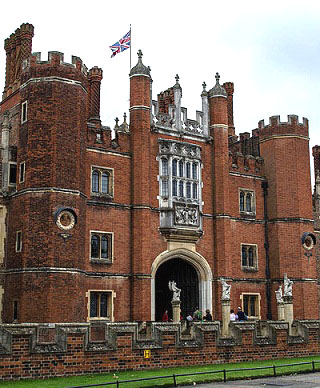
The Beautiful Hampton Court Palace
Hampton Court's history goes back 500 years to the Tudor monarchs and it has been the scene of many dramatic events.
It attracts visitors because of its history, its Tudor style architecture and the later additions by Sir Christopher Wren.
The Palace's grounds are also a great visitor attraction. Not only are the renowned for their beauty but also for the maze and for its annual flower show.
Hampton Court Palace During the Reign of the Tudors
In 1514, Thomas Wolsey bought the site on the River Thames and planned to rebuild his medieval manor there. The plans rapidly assumed the proportions of a magnificent palace with 280 rooms and spacious grounds surrounding it.
That same year, Wolsey became a cardinal and also King Henry VIII's Lord Chancellor. Some years later he fell out of favour and made a gift of Hampton Court to the king in a vain attempt to soften the king's attitude to him but in 1529 Henry declared all of Wolsey's lands and possessions forfeit and they became the property of the Crown.
Henry immediately began to extend the Palace adding rooms and buildings including more kitchens, library, towers and Water Gallery. Five of the king's six wives lived in the Palace and Anne Boleyn's initials can still be seen in the Great Hall. Henry VIII's third wife, Jane Seymour, died here and his fifth, Catherine Howard, was condemned and kept under house arrest here for adultery.
After Henry's death, Princess Elizabeth, as she was then, lived in and was held under guard in the Water Gallery because her sister, Queen Mary, suspected her of being involved in a threat to usurp the throne. When Elizabeth became Queen, it is said that she enjoyed gardening in the beautiful grounds. This was also a place where Queen Elizabeth entertained and held councils including the one that decided on the execution of Mary Queen of Scots.
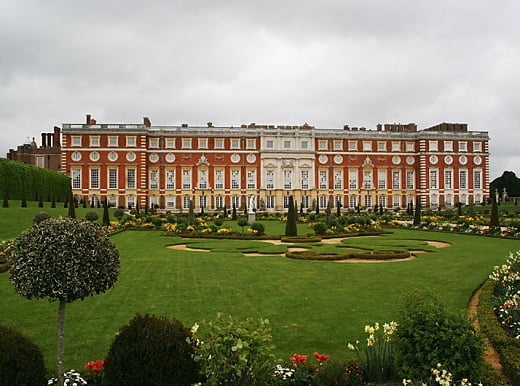
Changes to the Palace After the Tudors
When the first Stuart king, James I, ascended the throne, the Palace at Hampton Court still played a central role in the life of the monarch.
Shakespeare and his company performed plays here for the King and his court during the Christmas and New Year celebrations at the end of 1603. As the Great Hall in the Palace is largely unchanged since then, visitors can experience it in much the same way as Shakespeare must have done. It is almost certain that the great playwright and his company stayed in the Palace as there was plague in surrounding villages.
In 1604, the James I convened the Hampton Court Conference during which the King James Bible was commissioned. This was a landmark decision as this version of the Bible served the Church of England right into the late 20th century. Even today, many older people believe that it the most beautiful translation of the Bible and far superior to modern one but it was ever thus - what is familiar is always better!
In 1689, the joint monarchy of King William II and Queen Mary II was in place. During this period Sir Christopher Wren, architect of St Paul's Cathedral in London and many other notable buildings, was commissioned to rebuild large parts of the Palace.
Less than one hundred years later, in 1760, King George III did not want to use Hampton Court Palace as a residence. Instead the process of splitting it up into 'grace and favour' apartments began. These apartments are still awarded to people by the grace and favour of the monarch.
The Palace's last major brush with history came in 1944 when General Eisenhower used Bushy Park, part of Hampton Court's grounds during Tudor times, as his headquarters and it was there that he planned the D Day Landings for the invasion of Europe.
A Tour of Ghostly Hampton Court Palace
The Ghosts of Hampton Court Palace
Over the centuries, staff, visitors, workmen and residents have experienced strange phenomena for which there is often no practical explanation. Many of these experiences have been recorded and are presented below.
The Haunted Gallery - Catherine Howard
One of the best known hauntings at Hampton Court Palace is that of Catherine Howard, fifth wife of King Henry VIII. In November 1541, Catherine was charged with adultery and placed under house arrest. It is claimed that she broke free from her guards and ran down the gallery to reach her husband and plead for her life. The guards dragged her back and Catherine was later executed at the Tower of London. It is said that a female form, dressed in white, has been seen floating down the Haunted Gallery: 'towards the door of the Royal Pew, and just as she reaches it, has been observed to hurry back with disordered garments and a ghastly look of despair, uttering at the same time the most unearthly shrieks, till she passes through the door at the end of the gallery'. ( A Short History of Hampton Court by Ernest Law, 1897)
Clock Court - Jane Seymour
Henry VIII's third, and allegedly favourite, wife is said to walk through the cobbled courtyard carrying a lighted taper. She died following complications after the birth of Henry's only son, Edward, in 1537.
Sibell Penn - 'The Lady in Grey'
Sibell Penn was nurse to Prince Edward, Henry VIII's only son. She died in 1562 and was buried in Hampton Church. When the old church was pulled down in 1829, Mrs Penn's remains were disturbed and it is said that she returned to the rooms she inhabited during her time at Hampton Court Palace. The sound of a spinning wheel could be heard from behind a wall in the south-west wing of the palace shortly afterwards. When the wall was demolished, a small forgotten room was found, containing an old spinning wheel.
Sibell Penn is the most persistent ghost at Hampton Court Palace. There have been sightings as recently as 1986 when a 'lady in grey' was reportedly seen in various Tudor courtyards and cloisters.
The Wolsey Closet
This room has long been commented on by visitors, warders and other staff as having a "strange atmosphere". A caterer at an evening function refused to enter the little alcove in the room because he felt it was "evil".
A dog has been seen and heard in the room on more than one occasion, and the presence of a dog felt by somebody "sensitive" to such things.
Hampton Court's Tudor Kitchens
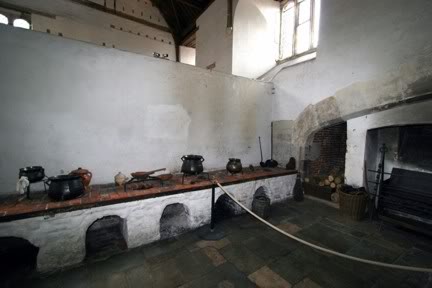

The Kitchens at Hampton Court Palace, extended by Henry VIII in 1529, occupied over fifty rooms and some three thousand square feet. In their heyday they were staffed by 200 people providing two meals a day for the 800 members of the king's court who were entitled to eat there.
Sited on the cooler, north side of Hampton Court Palace, the kitchens were reached through a separate gatehouse and grouped around three courtyards. The gatehouse was occupied by the Cofferer (the kitchen accountant) and his assistants.
The Spicery was situated in the western court and was filled with exotic spices imported from the Orient and Europe, as well as English mustard and herbs grown in the palace's own herb garden.
In the same courtyard as the Spicery was the Chandlery where wax (for candles and tapers) and linen were stored.
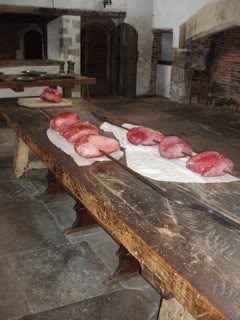
At the eastern end of the central court was the Great Kitchen with its six great fireplaces. One of these fireplaces retains its spit-racks, but the other five openings would have had similar cooking apparatus. At each end of the Great Kitchen were hatches at which liveried serving men would collect the finished dishes and take them to the Great Hall.
In the Confectory delicate sweet dishes were prepared for the more important members of the Court. It was here that the Awife who made the king's puddings worked - the only woman known to have been employed in the kitchen complex.
Of the three larders in the Tudor Kitchens, meat was hung in the Flesh Larder, fish was stored in the Wet Larder, and pulses and nuts were kept in the Dry Larder.
A list from the reign of Elizabeth I reveals the quantity of meat cooked in the royal kitchens in one year; 1,240 oxen, 8,200 sheep, 2,330 deer, 760 calves, 1,870 pigs and a modest 53 wild boar.
The palace had three cellars. The Wine Cellar was used to store the 300 casks of wine drunk by the Court each year and had a drinking house attached - presumably for wine tasting. Wine and ale for the King and Queen were kept in the Privy Cellar while the majority of the ale drunk by the Court - around 600,000 gallons each year - was stored in the Great Cellar. This had two locks on the door and the keys were held by two different officials for extra security.
Today, the Flesh Larder is stocked with pheasant, rabbits and wild boar and the Great Kitchens are laid out as if for the Feast of St John the Baptist in 1542. Pewter dishes are laden with pies and stuffed carp ready to be carried to the Great Hall.
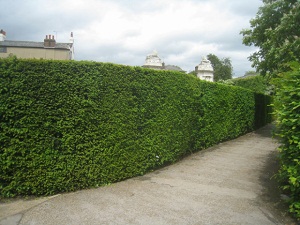
Hampton Court's World Famous Maze
The Hampton Court Hedge Maze, in Hampton Court's Riverside Gardens, might stand on the site of an earlier maze planted when Cardinal Wolsey owned the property. The present one was planted between 1689 and 1695 by George London and Henry Wise for William III (often known as William of Orange). It is now reputed to be the oldest surviving one of its kind in the world.
Facts
- The area of the maze covers a third of an acre.
- It has half a mile of paths.
- It stands in the 60 acres of Riverside Gardens.
- Originally hornbeam were planted but now they are only found in the centre of the maze. Everywhere else the hedges are yew.
- In 2006, Greyworld put in an audio art installation, Trace which plays different sounds in response to the pressure of footsteps or, on some benches, to somebody sitting down. There are about 1000 different sounds including laughter, whispers, a dog barking and rustling.
Visiting the Maze
In fact, this maze is not particularly difficult. The advice is to keep to the wall on the right even if it takes you into dead ends, you just follow them back the way you came! Doing this will eventually bring you to the centre, although it is doing it the long way.
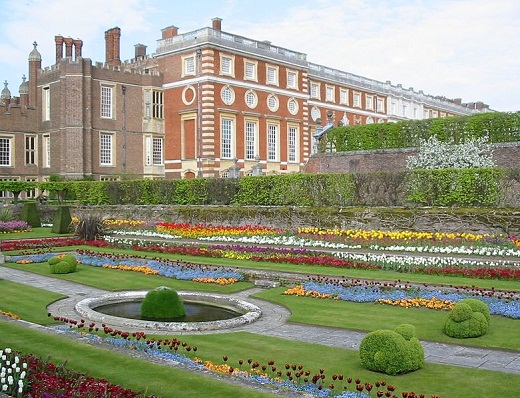
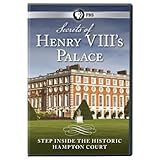
Hampton Court Gardens
Hampton Court Palace buildings cover an amazing 6 acres of land. It stands in extensive grounds: the gardens cover 60 acres between the Palace and the River Thames and the parkland covers 750 acres.
The gardens range from the formality of the the 18th century to collections of exotic plants. There is landscaped parkland where fallow deer, descended from Henry VIII's original herd, still roam. This is an area for other wildlife to flourish too.
The historic Long Water Avenue of lime trees, an important feature of the gardens, was planted in the 1660's by King Charles II as a gift to his new bride, Catherine of Braganza. A major conservation and restoration project to reinstate the historic vista of the Long Water Avenue was completed in May 2004 when HRH The Prince if Wales planted the last of 544 new lime trees that once again flank the central canal as Charles II would have known it.
The Golden Jubilee Fountain, created at the end of the historic Long Water Canal, was inaugurated in November 2002 by HM The Queen. It consists of five jets rising out of the eastern end of the canal, the largest of which is 30 metres in height.
Henry VIII's Garden and Hampton Court Palace
Hampton Court Palace Flower Show
The Hampton Court Flower Show Flower show has been held here since 1989 and is the largest of its kind in the world.
It is more inclusive than the Chelsea Flower Show although both are run by the Royal Horticultural Society. Visitors to the Hampton Court Flower Show can buy plants and take them home with them the same day whereas at the Chelsea Flower Show, all visitors can do is place orders to be received later.
At the Hampton Court event, gardeners still build their show gardens and those that are worthy of the honours receive gold, silver gilt, silver or bronze medal certificates. The most popular features of the show according to visitor surveys are the show gardens and floral marquees.
Exhibitors bring every conceivable gardening product known to man to the show to sell. There are plants of all kinds and from all over the world.
The final day of the show is the most exciting, especially for visitors who like a bargain - and who doesn't? Many exhibitors sell off display plants at low prices. The sell-off starts at 4.30pm on the final day and lasts for an hour until the show closes and all visitors must leave the showground. You will see people struggling to their cars or on to buses with enormous plants or dozens of smaller ones.
© 2008 Carol Fisher







